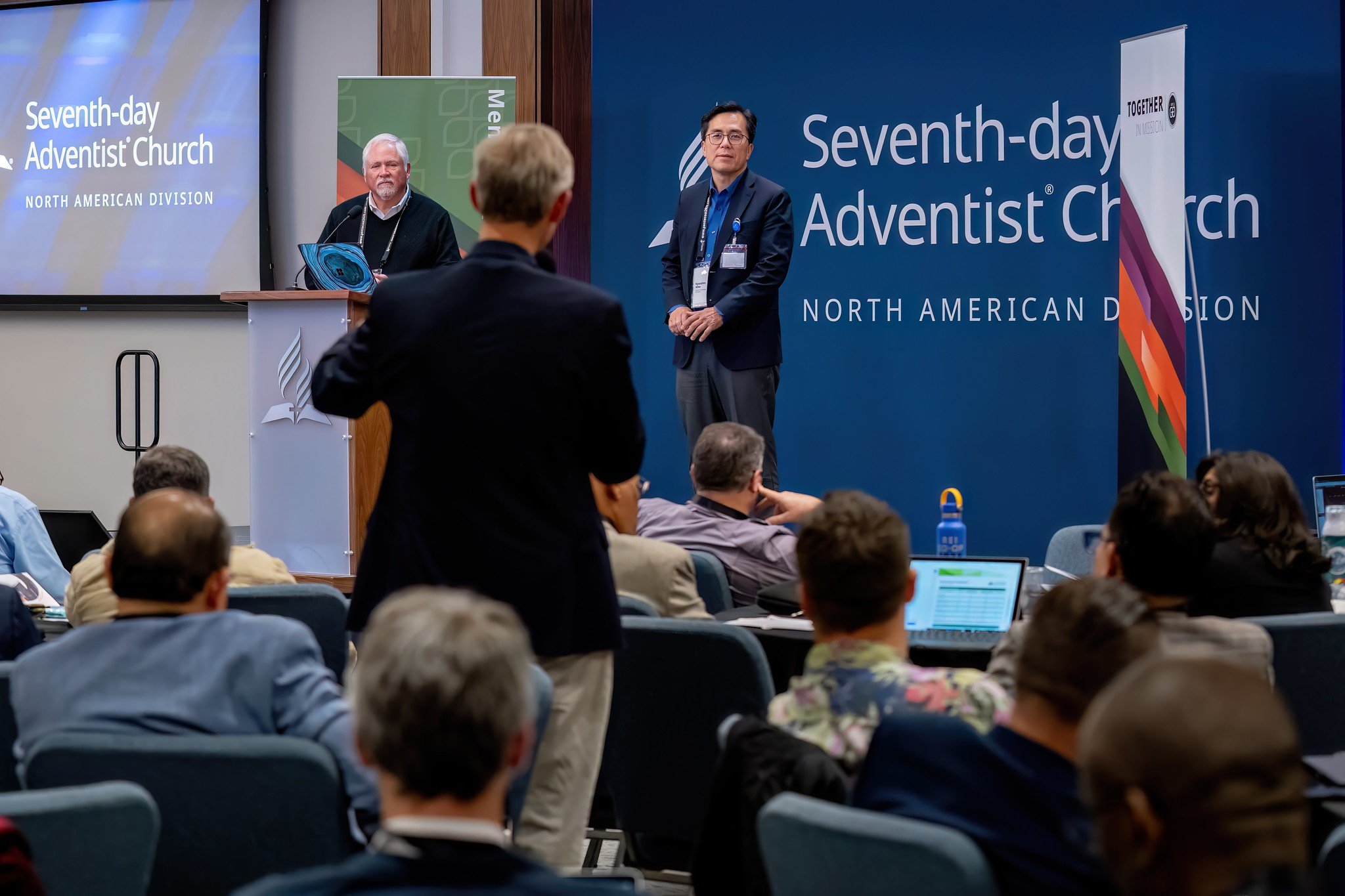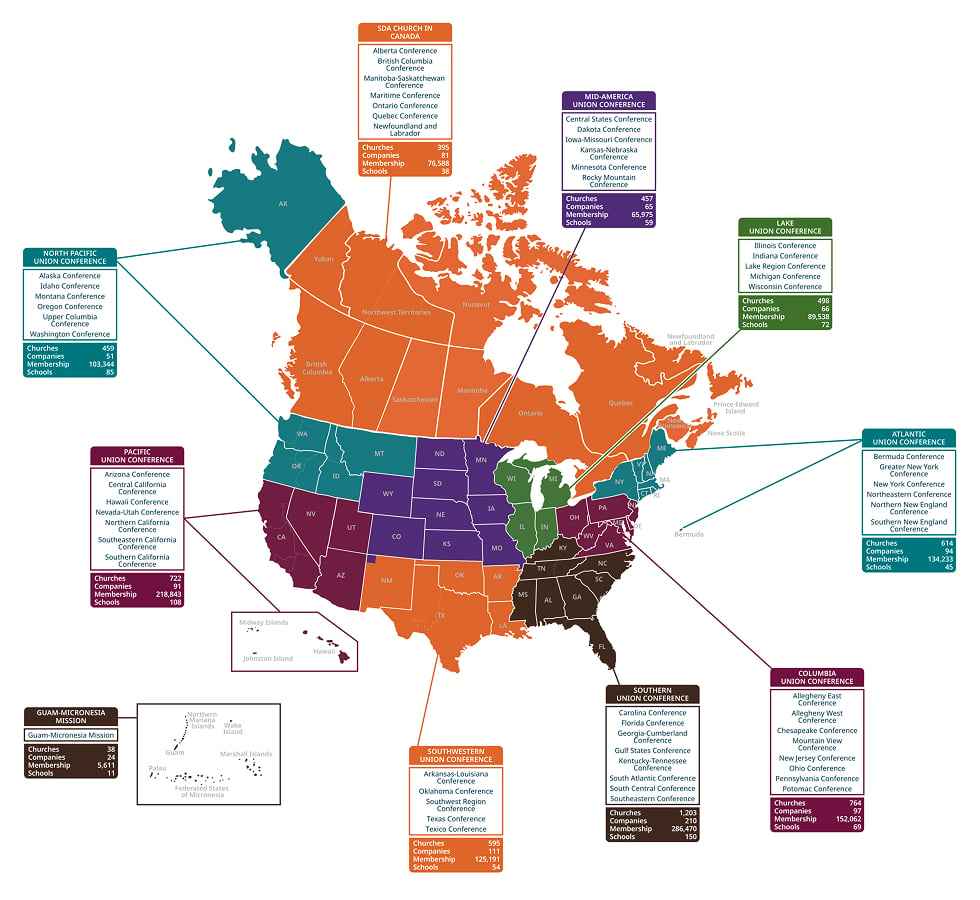How the Church is Organized
The Seventh-day Adventist Church operates through a representative form of government whereby a representative constituency, beginning with local church members, selects their leaders. At duly called constituency sessions, Adventist members vote for their representatives at the local, regional, and global levels. The denomination consists of increasingly expanding regions of church governance that advance the mission of the denomination around the world.
Churches
The local church is where individual believers are active and participate in weekly worship and other relational groups for Bible study, Sabbath School, worship, as well as various forms of community service, evangelism, and outreach. The local church or churches serve as the constituency for the local Adventist school, if one is available, and provides opportunities to grow spiritually. From local church members, each church selects its local church leaders and works closely with a pastor or group of pastors to provide governance within the local congregation.
Missions and Conferences
Groups of churches in a region are organized into groups known as a mission or conference. A mission is supported externally where the local church members are not able to support themselves. When a group of Adventist churches appears in a conference, usually reflecting a regional territory, state, or province, help to coordinate the work of these churches collectively, especially with the hiring of pastors and teachers, and retain ownership of church properties within the particular territory.
Union Conferences
A group of missions and/or conferences is clustered into larger groups of Union Conferences. Across North America, there are nine Union Conferences. The Union Conference oversees the accreditation of elementary and secondary schools, ensures that auditing takes place if there is an Adventist college or university, and generally serves as the constituency for a union-sponsored entity or school.
General Conference
The General Conference coordinates the mission of the worldwide Seventh-day Adventist Church. Typically, every five years, a General Conference Session elects leaders and votes on the denomination’s Working Policy, makes changes to any statements of Fundamental Beliefs or The Church Manual, and elects an executive committee that reviews and makes decisions between General Conference Sessions. The General Conference has departments in the areas of education, healthcare, publishing, media (radio, print, media), development and relief, and more.
Each level of church governance is “representative,” meaning that it reflects a democratic process to elect leaders and review important policies and budgets. Local churches elect their own officers and church boards by a majority vote of the body. At each level of governance, delegates and various administrative officers meet “in session,” through which they elect various officers and committees, receive reports, and vote on the appropriate budget and other policies. Executive authority between sessions is exercised at each level by an Executive Committee consisting of the executive officers (typically the President, Secretary, and Treasurer), all of whom are elected at a duly called constituency session that is held based upon the duly established constitution and bylaws.
Divisions/Regional Headquarters
Divisions are sections of the General Conference, with administrative responsibility for particular geographical areas. There are currently 13 such administrative entities.
North American Division
The North American Division was first formed in 1913 but was phased out five years later by an action taken at the 1918 General Conference Annual Council. This returned it to the pre-1913 model, where it operated without being a separate division. Thus, for most of the twentieth century, the work in North America was led by one of the vice presidents of the General Conference. Then, in 1985, due to growing missional needs, the North American Division was reformulated as one of the 13 divisions of the world church. Charles Edward Bradford served as the first president. For the next 30-plus years, it continued to operate in a shared building with the General Conference until 2017, when it moved into its current location in Columbia, Maryland.
We serve the territories of Bermuda, Canada, Guam/Micronesia, and the United States.
Atlantic Union Conference
Organized in 1901
Territory: Bermuda, Connecticut, Maine, Massachusetts, New Hampshire, New York, Rhode Island, and Vermont; comprising the Bermuda, Greater New York, New York, Northeastern, Northern New England, and Southern New England Conferences
News magazine: Atlantic Union GLEANER
Seventh-day Adventist Church in Canada
Organized in 1901; reorganized in 1932
Territory: Canada and French possessions of St. Pierre and Miquelon; comprising the Alberta, British Columbia, Manitoba-Saskatchewan, Maritime, Ontario and Quebec(French website) Conferences and theSeventh-day Adventist Church in Newfoundland and Labrador
News magazine: Canadian Adventist MESSENGER
Columbia Union Conference
Organized in 1907
Territory: Delaware, Maryland, New Jersey, Ohio, Pennsylvania, Virginia, and the District of Columbia; comprising the Allegheny East, Allegheny West, Chesapeake, Mountain View, New Jersey, Ohio, Pennsylvania, and Potomac Conferences
News magazine: Columbia Union VISITOR; Archives; Visitor News Bulletin
Guam-Micronesia Mission
Became part of North American Division in February, 2012
Lake Union Conference
Organized in 1901
Territory: Illinois, Indiana, Michigan, Wisconsin, and a portion of Minnesota; comprising the Illinois, Indiana, Lake Region, Michigan, and Wisconsin Conferences
News magazine: Lake Union HERALD
Mid-America Union Conference
Organized in 1980
Territory: Colorado, Iowa, Kansas, Minnesota, Missouri, Nebraska, North Dakota, South Dakota, Wyoming, and San Juan County in New Mexico; comprising the Central States, Dakota, Iowa-Missouri, Kansas-Nebraska, Minnesota, and Rocky Mountain Conferences
News magazine: Mid-America OUTLOOK
North Pacific Union Conference
Organized in 1906
Territory: Alaska, Idaho, Montana, Oregon, and Washington; comprising the Alaska, Idaho, Montana, Oregon, Upper Columbia, and Washington Conferences
News magazine: Northwest Adventists
Pacific Union Conference
Organized in 1901
Territory: Arizona, California, Hawaii, Nevada, Utah, Johnston Island, Midway Islands, and all other islands of the Pacific not attached to the other divisions and bounded by the date line on the west, by the equator on the south, and by longitude 120 on the east; comprising the Arizona, Central California, Hawaii, Nevada-Utah, Northern California, Southeastern California, and Southern California Conferences
News magazine: Pacific Union RECORDER
Southern Union Conference
Organized in 1901; reorganized in 1932
Territory: Alabama, Florida, Georgia, Kentucky, Mississippi, North Carolina, South Carolina, and Tennessee; comprising the Carolina, Florida, Georgia-Cumberland, Gulf States, Kentucky-Tennessee, South Atlantic, South Central, and Southeastern Conferences
News magazine: Southern Union TIDINGS
Southwestern Union Conference
Organized in 1902
Territory: Arkansas, Louisiana, New Mexico (except San Juan County), Oklahoma, and Texas; comprising the Arkansas-Louisiana, Oklahoma, Southwest Region, Texas, and Texico Conferences
News magazine: Southwestern Union RECORD
Adventist Church 101
One Movement, Many Parts
Learn how the over 80,000 Seventh-day Adventist churches worldwide are linked together in mission.
Nominating Committee
Learn about the role of the Nominating Committee in selecting leadership roles for the local church.
Constituency Sessions
Church governance is expressed by Constituency session, the meeting of delegates to conduct essential business.

